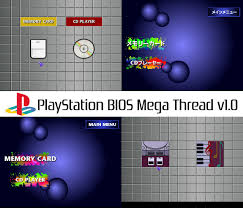ps1 bios download
 Emulation is all the rage in PC gaming. Not only does it let you relive the glory days of retro titles on your computer, it also
Emulation is all the rage in PC gaming. Not only does it let you relive the glory days of retro titles on your computer, it also
often permits you to improve your experiences with those matches. Going back to play with an old game — particularly from the PS1
era — may frequently surprise individuals that are surprised by how much better these titles seem through nostalgia glasses.
With RetroArch PS1 emulation, you are able to upscale and tweak these games into a thing that looks a whole lot closer to what you
recall — and even better.
Meet RetroArchRetroArch is not an emulator in and of itself — think of it as a hub to get emulators and networking accessible
beneath one, unified interface. Emulating games on PC generally means a full emulator and distinct app per platform, however
RetroArch can actually emulate fairly a significant number of systems, all within one program.
RetroArch’s emulators, known as”cores,” are generally ported emulators from different programmers in the spectacle. Some
emulators, nonetheless, are now made just for RetroArch, and as a result of this they might even be better than modern standalone
emulators on the scene.
Here is the case for top RetroArch PS1 center, Beetle PSX, which we are going to be teaching you how to install and utilize in
this report.
PS1 BIOS, Gamepad, and Other Things You Want For optimum RetroArch PS1 emulation, then you’ll need the following:
* A contemporary gamepad with dual-analogs. I recommend that a PS3 pad for that authentic control encounter or a Xbox One pad to
get improved support. When utilizing a non-Xbox pad, make sure that you have an XInput driver/wrapper enabled.
* A contemporary Windows PC for best performance (and the most precise manual ) however RetroArch is cross-platform enough for
this manual to work on other platforms. Expanding marginally on the notice of BIOS documents, we can’t legally tell you the
best way to obtain them. What we can tell you is that the most Frequent bios documents are:
You can check the default option that Retroarch scans for BIOS files under”Preferences -> Directory -> System/BIOS”.
Notice that the BIOS file names are case-sensitive, therefore have to get written without caps, and suffixed with’.bin’.
A Couple of Settings to TweakAs long as you’ve got an XInput-enabled gamepad, you won’t need to do a great deal to have an
excellent RetroArch PS1 emulation encounter. Howeverthere are a couple things you’re likely to need to tweak to get a perfect
experience. First, go over to”Options -> Input.”
Now, use Left/Right on your own D-Pad to Choose a Menu Toggle Gamepad Combo. I recommend placing L3 + R3 as your shortcut. .
If you’ve followed to this point, your controller is ready to use, and you’ve acquired the PS1 bios document (s) that you’ll
have to play your own games. Some games may work with no BIOS, however for full compatibility we highly recommend you.
Now, let’s get to the juicy stuff: set up the emulation center.
Having difficulties with Retroarch? Take a peek at our listing of Retroarch fixes and see if they help.
Produce”.cue” Documents for Your PSX GamesWhen you rip a PS1 game, you should always make sure you do it into the BIN or even
BIN/CUE format. Free to dowload roms ps1 bios download At our site This may basically divide the output into the BIN file, which stores most of the game information, as well as
also the CUE file, that is exactly what Retroarch searches for when you scan for PS1 games.
When for any reason you don’t possess the”cue” file accompanying your”bin” file, or if your ripped PS1 match is in a different
format like”img”, then you will want to create a”cue” document for that match and set it into the identical folder as the main
image file.
Developing a CUE file is simple enough, and also to make it much simpler you can use this online tool to create the text to get
a cue file. Just drag-and-drop the game’s img or bin file into the box on the site, and it’ll create the”cue” document text for
it. Be aware that when the ripped PS1 game is divided into various audio tracks, you should copy all of them into the internet
tool also, so all the game files are all included in one”cue” file.
Then copy-paste the cue file text into a Notepad file, then save it with the specific same file name because the game’s key
image file, and then save it in precisely the same folder as the primary image file.
Now, when Retroarch scans for your own PS1 games (which we’ll move onto soon ), then it will see them from the”cue” files you
generated, and add them to your library.
First, head to the Main Menu, then select Online Updater.
Within Online Updater, pick Core Updater.
You could even pick the non-HW version, but I suggest using HW rather than Select it to put in it.
Once installed, head back to the Main Menu and split Center.
Find PlayStation (Beetle PSX HW) and select it! This will load the Core to RetroArch.
You have set up the center. But how do you put your matches into RetroArch proper?
Launch Retroarch PS1 GamesHead back to Main Menu and select Load Content.
Pick colors.
Select Scan Directory.
In order for this to work correctly, you need to get every one of your PS1 game files stored in 1 folder on your computer. If
you don’t, have them organized and take note of where they’re in Windows Explorer to locate them at RetroArch. Mine, by way of
instance, are situated on my secondary hard disk in”Emulation/PS1/Games.”
Now they’re here, you can return to the Main Menu. If you scroll over to the best, you are going to realize there is a new menu
built to hold your PS1 games. I’ll start Crash Bandicoot — Warped out of here.
In-Game: TweakingYou’ve done it. You’re at the match and ready to begin playingwith. But wait — the graphics look discounted
and pixelated! How can you mend this?
Hit on the gamepad combo you place for opening the menu at the game before. For me, this really is L3+R3.
From the Main Menu, there’s now a”Quick Menu” option. Select it.
Inside Quick Menu, you will see a lot of different alternatives. Let’s cover the ones that are applicable.
Even the”Save State” options permit you to save a game’s condition — pretty much exactly where you are. There are a number of
slots that you save in, and you’re able to use these to bypass ordinary saving or before a tricky segment you want to keep
trying. It’s Your Choice. Or you can forgo them completely!
In case your analog sticks aren’t being picked up, you could be playing a PS1 game that doesn’t support them. To fix this,
visit Controls and set”User 1 Analog To Digital Type” to Left Analog.
Ensure”vulkan” is chosen or use”opengl” in case your GPU does not support it. Vulkan is the best option, though, and ought to
offer whole access to the additional features offered by RetroArch PS1 emulation.
In-Game: Pictures Restart if necessary. Here are the relevant ones and what to do together.
* Software framebuffer/adaptive smoothing — Maintain these on.
* Internal GPU resolution — Artificial is 240p, 2x is 480p, 4x is 720p, 8x is 1080p, and 16x is 4K. These are not accurate,
but they are pretty much what you ought to expect out of caliber — we recommend using 8x if your hardware can handle it, or
even 16x if you would like to forgo the demand for AA and possess the hardware power to it.
* Texture filtering — Multiple configurations, however xBR and SABR are the best and shouldn’t require too much
functionality.
* Internal color depth — Change this from the 16bpp default to 32bpp to get a bump in colour depth at minimal performance
cost.
* Wireframe/full VRAM — Leave them alone.
* PGXP Operation Mode — Switch this on to take advantage of some of the benefits of RetroArch PS1 emulation. Set it
into”memory just” for the least visual glitches. Performance + CPU does look good in some games but may others.
* Widescreen Mode Hack — This will result in some visual glitches on the outer borders of your screen but should seem good in
many games. Personal preference.
ShadersShaders are visual filters which let you add all kinds of crazy things on your in-game images. It is possible to smooth
out edges using various levels of antialiasing, give a border to a game, or attempt to recreate the authentic experience of
playing a 90s screen with the addition of a bit of sound or scanlines into the image.
Here, apart from the”presets” folder, and you will find three types of shaders — cg, glsl and slang. Which one of these you
use will be based on what video drivers you are using and the ability of your PC (shaders can be very graphics-intensive).
CG shaders are used for lower-end PCs and are harmonious with gl and DirectX video motorists, GLSL operate only with OpenGL
drivers and Slang are exclusively for Vulkan.
With that in mind, head into whatever shader folder is relevant for your own driver and have a play about.
It is possible to add cel shading to a match in the”cel” box as an example, smooth out borders in the anti-aliasing shaders
folder, add CRT scanline effects under”crt” and so on.
When you allow a shader, it is going to take effect right away, permitting you to determine if you would like to maintain it.
If you’re feeling brave, you may even go into”Shader Parameters”, then fine-tune that shader for your liking, then save it as a
new shader simply by heading to”Save Shader Preset Just as” from the Shader menu.
Shader Passes lets you use several shader filters concurrently (you are going to realize that many shader presets already
utilize a few’Passes). Be aware that every additional overhaul is more strenuous on your PC.
Comment below in case you have any remaining questions and tell us what you will be playing.










